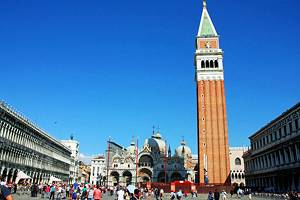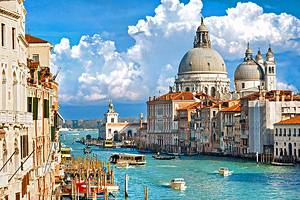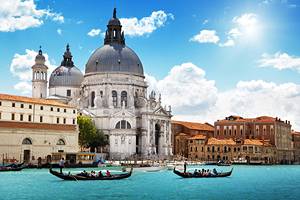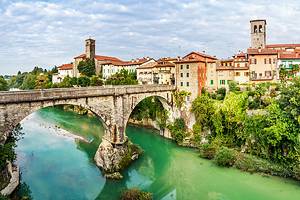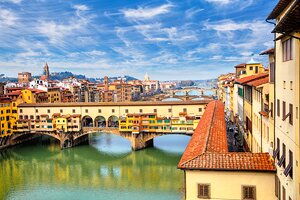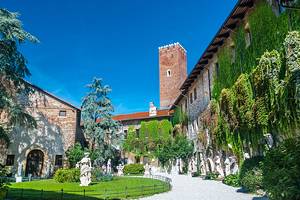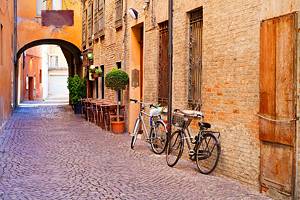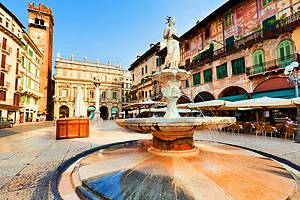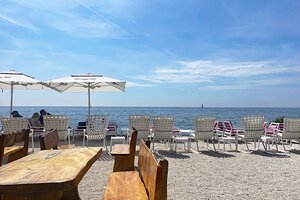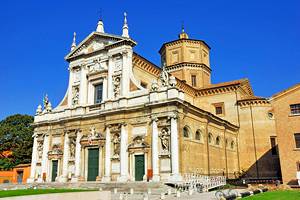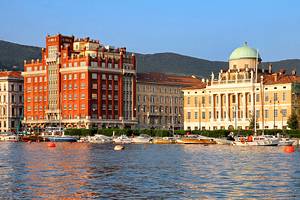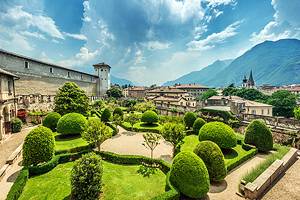Exploring St. Mark's Basilica in Venice: A Visitor's Guide
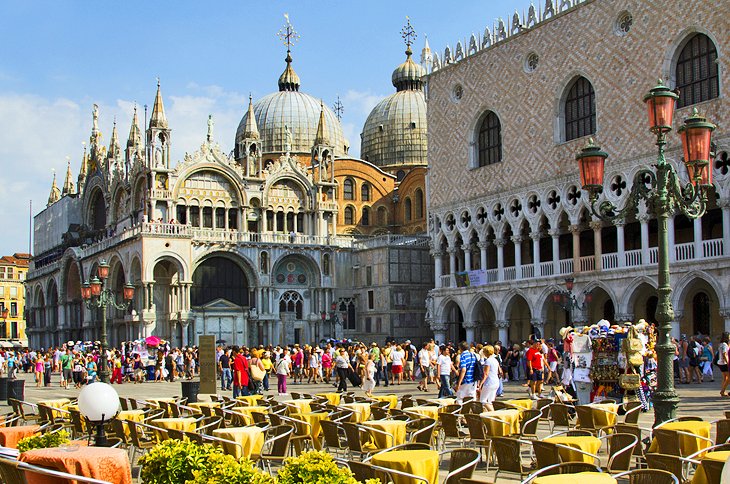
Originally the chapel of the Doge, St. Mark's Basilica (Basilica di San Marco) became important in 829, when the remains of St. Mark came to Venice from Alexandria and were interred here. The present ground-plan, derived from the Church of the Apostles at Constantinople, dates from 1063.
In 1075, the Doge passed a law requiring all returning ships to bring back something precious to decorate the basilica, accounting for the more than 500 columns of rare marble, porphyry, alabaster, and jasper brought back from the East. The interior is clad with 4,240 square meters of gold mosaics, mostly from the 12th and 13th centuries.
Between 1500 and 1750, some of the old sections were replaced by "modern" mosaics designed by artists including Titian and Tintoretto. The mosaics, golden altar, beautiful chapels, and treasury make it one of Italy's best-loved tourist attractions.
On This Page:
North and South Façades
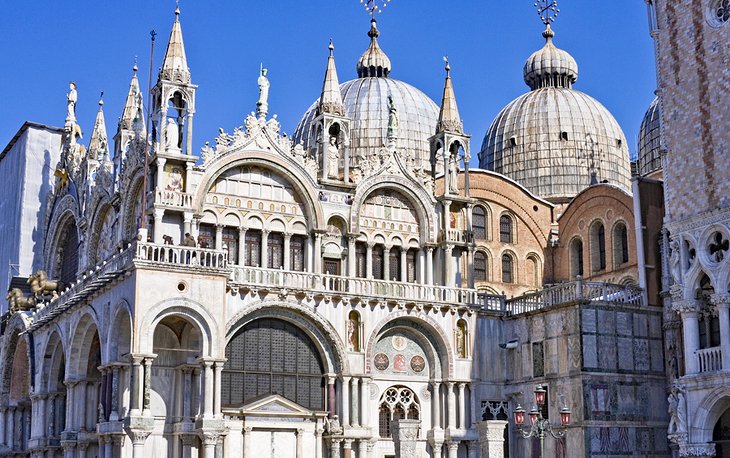
Until 1503, when the south facade was enclosed, it was intended to be an imposing ceremonial entrance facing the lagoon. But even with the Doge's Palace covering a good part of it, this façade is still an arresting sight from the Grand Canal. Sculptures and mosaics add to its richly detailed architecture. Along with the two griffins in the first arch, notice the 13th-century Byzantine mosaic of the Virgin between the arches of the upper floor.
In front of the facade are two marble pilasters, Pilastri Acritani, covered in magnificent sixth-century reliefs. Like St. Mark himself, these were spoils of war, carried off by Venetians in 1256 from the port of Acre. The sculpture of the Tetrarchs on the corner was hewn from porphyry, probably in Egypt in the fourth century.
The north facade facing the Piazzetta dei Leoncini, contains the Porta dei Fiori, the Door of Flowers, with a beautiful 13th-century relief of the Nativity, framed by foliage, angels, and prophets. Two other reliefs are the seventh- or eighth-century depiction of a judge's throne with six sheep on each side (symbolizing the Twelve Apostles), and Alexander the Great's chariot, drawn by griffins, from the 10th century.
Porch and Gallery
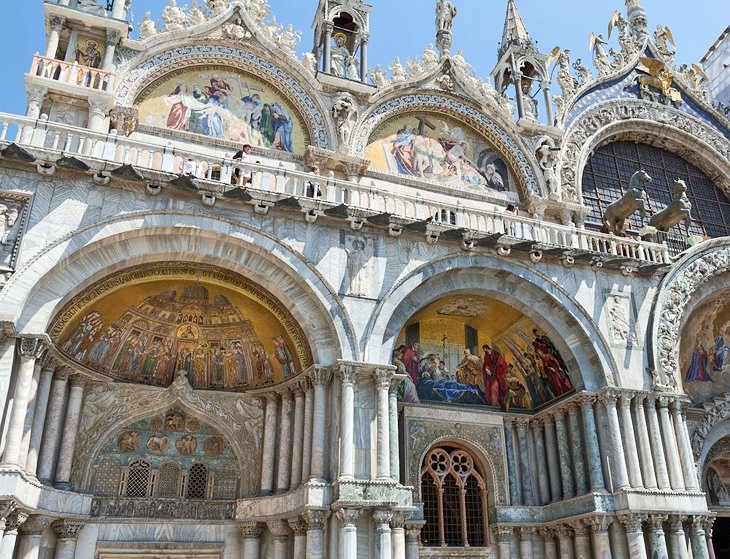
Like all Byzantine basilicas, St. Mark's has a porch (narthex) that provides a foyer before entering the main church. The mosaics of its domes and arches are from the 13th century, except for the St. Mark added in the vaulting in 1545. They represent (right to left) the Creation, Cain and Abel, Noah's Ark, the Tower of Babel, and the stories of Abraham, Joseph, and Moses.
Each of the three portals leading into the church is flanked by marble columns with highly ornamented capitals from the sixth through ninth centuries. The right portal has a 10th-century bronze door covered in silver with an inscription in Greek. The tombs of Doges in the outer wall are from the 12th century.
Above the narthex is an open gallery, and until 1981, the four famous bronze horses stood there looking out over Piazza San Marco. They were once part of a quadriga in the Hippodrome of Constantinople, thought to be from the third or fourth centuries.
These were among the booty brought to Venice by Doge Enrico Dandolo after the fall of Constantinople. In 1797, Napoleon carried them off to Paris, but they were returned to Venice in 1815. You can see the originals in the Museo Marciano. In 1981, threatened by air pollution they were again moved, this time to the basilica's Museo Marciano. The four horses on St. Mark's balcony today are exact reproductions.
Interior and Mosaics
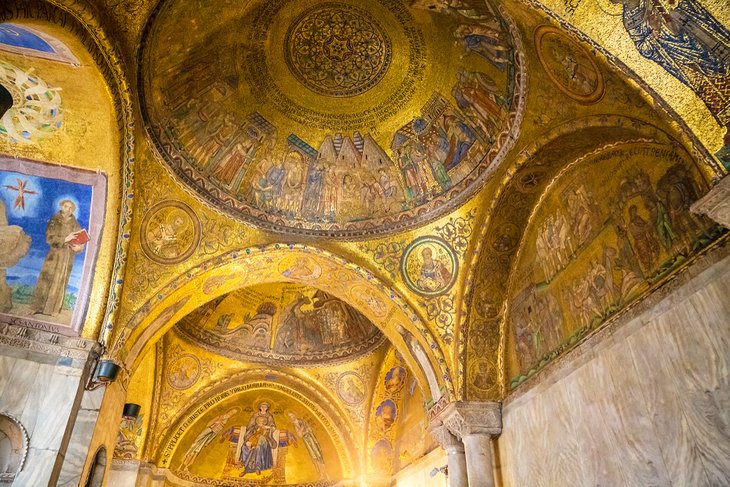
It's almost impossible to choose a single highlight of this treasure-filled basilica, but the mosaics are the first sight that will take your breath away. Combined with the shape of the church, they give the immediate impression of Byzantine, even though the interior mixes a wide variety of architectural styles from classical to 19th century.
It is a tenet of the Byzantine that separates the form and function of a church into earthly and heavenly portions, and the part of St. Mark's overhead certainly rises above earthly bounds in a celestial luminosity of tiny colored glass pieces and gold leaf.
Each of the five domes, borne on huge pillars, is almost 13 meters in diameter and has 16 windows. The sumptuous gold mosaics that cover the domes, a total surface area of 4,240 square meters, give rise to its popular name, Basilica d'Oro – Golden Basilica.
Most of the dome mosaics date from between 1160 and 1200, with the oldest above the choir. The best view of them is from the galleries, near the museum. The first dome from the entrance shows the dove of the Holy Ghost in the center of a halo that extends to the surrounding Apostles. The central dome shows Christ surrounded by stars and below, Mary between two cherubim and the Apostles. In the Cappella di San Giovanni, above the north transept, are 12th-century mosaics of the life of St. John.
Pala d'Oro
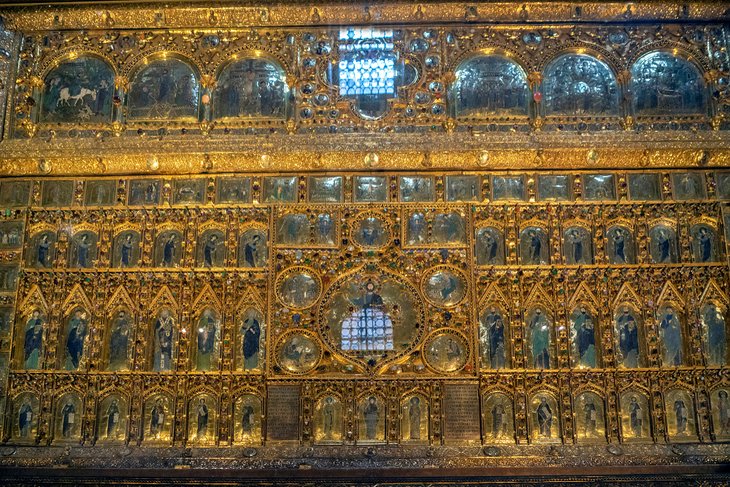
When you stand before San Marco's magnificent golden retable, it's easy to understand why it is considered among the most sublime expressions of Byzantine religious art. Measuring 3.45 meters long and 1.4 meters high, it is one of the finest altarpieces in all Europe. The oldest sections are the circular gold and enamel plates on the rim.
The artistry is a mixture of work by Venetian craftsmen and those from Constantinople and combines intricate gold work with enameled medallions depicting the life of Christ, the life of St. Mark, and other biblical themes. The work continued over five centuries, as new elements were added.
The lower section dates to 1102-1118 as do the enamels with stories of St. Mark. The series of six Byzantine celebrations portrayed in the upper part, along with the central Archangel Michael are thought to have come from Constantinople after 1204.
The last additions were between 1343 and 1345 when Doge Dandolo charged two Venetian goldsmiths with framing the whole altar in a Romanesque arch at the top and a lower Gothic arch. It was then that the nearly 2,000 gems and precious stones were set in place. Along with 300 emeralds, these include rubies, garnets, sapphires, amethysts, topazes and 1300 pearls.
Inlaid Marble Floor
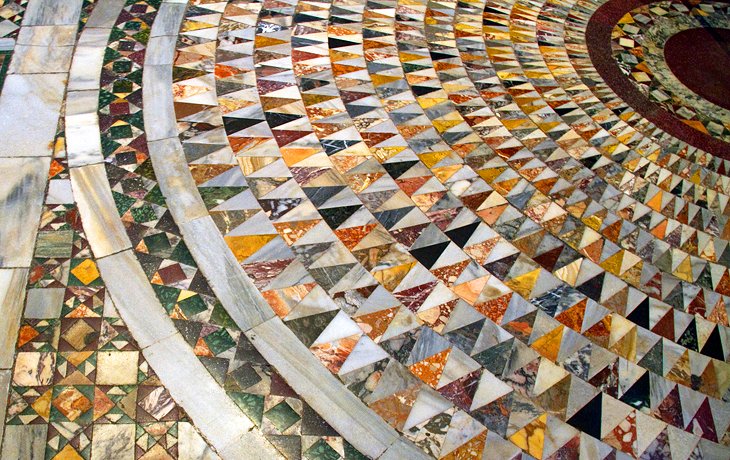
Just as the domes and ceiling portray the celestial realm, St. Mark's follows the Byzantine church architectural tenets by creating a floor that underscores earthly solidarity. Marble inlay covers 2,099 square meters in rich earth tones set in intricate geometrical and natural patterns.
While most of the floor is geometric, it is lightened occasionally with intricate animal and floral designs made with tiny pieces of marble or even glass. It is thought that the artists who created the floor, like those who did the mosaics above, came from Constantinople or Greece.
Transept Chapels
In the short arms that extend at either side of the main dome, are a number of chapels dedicated to the Madonna and to various saints, each one with beautiful decoration and art treasures. Cappella della Madonna dei Máscoli has Gothic altar sculptures and mosaic vaulting, both from the 15th century.
Cappella di Sant'Isidoro contains the saint's remains in a wall sarcophagus and is decorated with mid-14th-century mosaics. The altar in Cappella della Madonna Nicopeia, also on the north side of the transept, features the priceless Byzantine icon of the Madonna Nicopeia, set with jewels, pearls, and precious stones and in a delicate Byzantine enamel frame. Highly venerated by the Venetians, the icon was booty brought from Constantinople in 1204. Cappella di San Pietro has a 14th-century altar screen, along with a good view of the high altar and mosaics in the choir.
In the south transept, Cappella di San Clemente is the former Doge's chapel, with a dividing wall of late 14th-century columns and a 12th-century mosaic of St. Clement in the apse. The Sacramental Altar to its south dates from 1617. In front of it is the place, marked by a mosaic in the floor, where the relics of St. Mark were rediscovered after they had been lost in the fire of 976. Twelfth-century mosaics picture parables and miracles of Christ.
Rood-Screen and Sanctuary
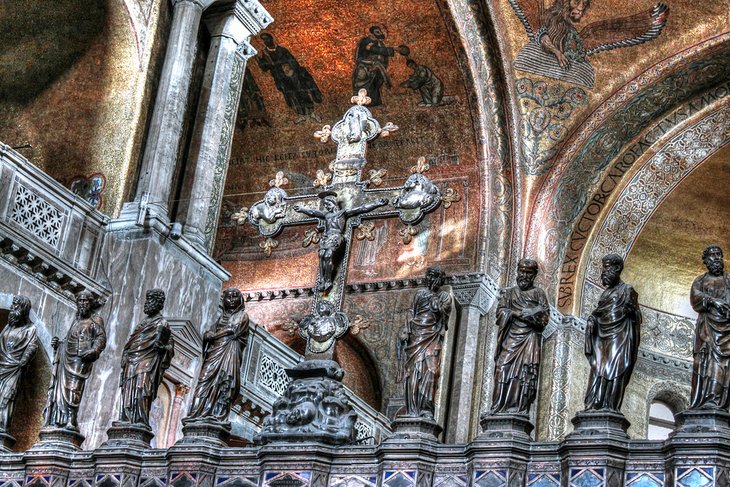
The choir is separated from the nave by an intricate rood-screen. The lectern, with a silver Crucifix and the statues of the Madonna, St. Mark, and the Apostles, was the work of Jacopello and Pierpaolo dalle Masegne from 1394 to 1404. The pulpit on the right was where the newly elected Doge was traditionally presented to the people.
The bronze reliefs in the choir, worked by Jacopo Sansovino from 1537 through 1541, show scenes from the story of St. Mark, whose relics are housed in the High Altar. The four columns supporting the ciborium, an architectural canopy above the altar, are decorated with 324 reliefs from the 13th century showing scenes from the life of Jesus and Mary.
Treasury

The Treasury, which you can enter from the corner of the south transept, is full of the precious objects brought home by the Venetians from Constantinople in 1204. With 283 pieces in gold, silver, and other precious materials, it is one of the most important and richest church treasuries in Europe, even after plundering by Napoleon and the sale of some of its gems to pay for essential restoration of the church in the early 1800s.
Among the Constantinople booty were 110 gold and silver Byzantine reliquaries set with precious stones, works of the 11th to 13th centuries. Byzantine icons made of gold and silver, chalices, glassware, Islamic art, Venetian filigree, enameled goldwork, and later, gifts from popes, European princes, or doges complete the collections.
A few highlights to look for are the sumptuous throne of the Doges, two beautiful fish-shaped lamps sculpted in crystal, amphorae carved from a single block of agate, cloisonné enameled chalices, icons of the Archangel Michael, and the perfume-brazier in the form of a small building with five cupolas.
Museo Marciano
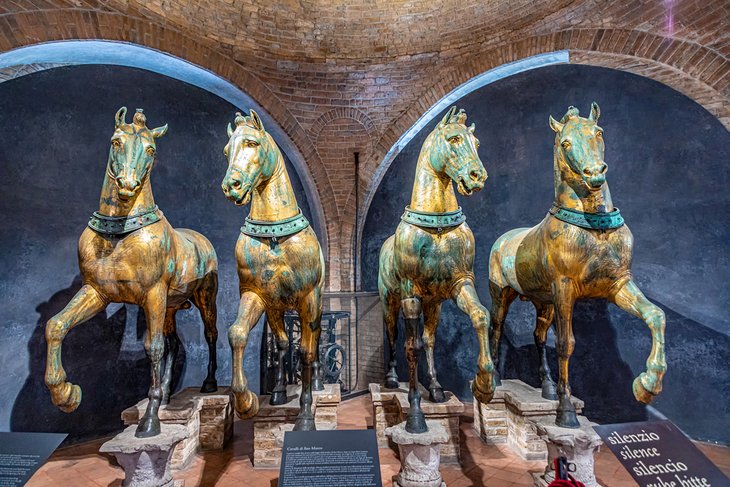
A small door near the main entrance to the church leads up to the museum, where you'll find the originals of the four famous horses that once stood on the gallery over the main entrance. These much-traveled gilded copper horses were part of the war booty taken from Constantinople, again plundered by Napoleon, returned to the gallery, and finally brought here for preservation.
Look, too, for magnificent 13th- to 16th-century Gobelin tapestries, 12th-century Byzantine sculptures, and a beautiful cover for the Pala d'Oro, made in 1345 by Paolo Veneziano and his sons, showing scenes from the life of St. Mark.
Practical Tips: How to Make the Most of Your Visit to St. Mark's Basilica
- Timing: This is one of the top attractions in the city, so expect to wait in a long line. The best times to arrive are very early morning and around noon, when tour groups go to lunch. Or you can avoid lines entirely by reserving a time in advance through the website.
- Dress Code: This is a place of worship, so dress accordingly (women's shoulders should be covered, shorts are not appropriate, and men must wear shirts).
- Best Views: For the best views of the mosaics, go to the gallery, near the entrance to the museum. Bring binoculars for a closer look.
- Food and Drink: Cafés and restaurants are all around St. Mark's Square and along the Grand Canal, only a few steps from the basilica.
Frequently Asked Questions about St. Mark's Basilica
Do I have to pay to visit St. Mark's?
You can enter St. Mark's free, but you may have to wait in a long line, and you must pay separately to see the Treasury, the Marciano Museum, and the Palo d'Oro. For a small fee, you can avoid the lines.
Can I visit St. Mark's on Sunday?
The basilica opens to visitors at 2pm on Sunday.
Does St. Mark's have wheelchair access?
Yes, those with limited mobility can enter at the left side of the building, through the Porta dei Fiori, which is equipped with a ramp. The Treasury is also accessible from this entrance, and there is a lift to the museum.
Can I bring a backpack into St. Mark's?
No, but you can check it or other luggage at the Ateneo San Basso, in the Piazzetta dei Leoncini, at the north façade to the left of the main entrance.
Getting to San Marco
- Take a vaporetto, the boats that make up Venice's transport system, to San Marco or San Zaccaria stops, the closest to the basilica. Street signs throughout the city point to San Marco.
Address
- Piazza di San Marco, Venice
- www.basilicasanmarco.it
Venice - Climate Chart
| Average minimum and maximum temperatures for Venice, Italy in °C | |||||||||||
| J | F | M | A | M | J | J | A | S | O | N | D |
| 6 -1 | 8 1 | 12 4 | 16 8 | 21 12 | 25 16 | 28 18 | 27 17 | 24 14 | 18 9 | 12 4 | 7 0 |
| PlanetWare.com | |||||||||||
| Average monthly precipitation totals for Venice, Italy in mm. | |||||||||||
| 58 | 53 | 58 | 64 | 69 | 76 | 64 | 84 | 66 | 69 | 86 | 53 |
| Average minimum and maximum temperatures for Venice, Italy in °F | |||||||||||
| J | F | M | A | M | J | J | A | S | O | N | D |
| 42 30 | 46 33 | 53 38 | 61 46 | 70 54 | 76 60 | 81 64 | 80 63 | 74 57 | 64 48 | 52 39 | 44 32 |
| PlanetWare.com | |||||||||||
| Average monthly precipitation totals for Venice, Italy in inches. | |||||||||||
| 2.3 | 2.1 | 2.3 | 2.5 | 2.7 | 3.0 | 2.5 | 3.3 | 2.6 | 2.7 | 3.4 | 2.1 |
More Related Articles on PlanetWare.com
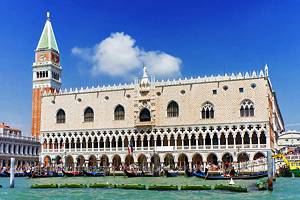
What to Do in Venice: Next to the basilica, you'll want to explore the Doge's Palace and then see all the other attractions in Piazza San Marco. And along with exploring the city, don't forget that there are interesting things to see and do on day trips from Venice.

Where to Go from Venice: You can take a direct train to visit romantic Verona, one of the best places to visit in Italy. Between Venice and Verona, you can also stop to visit the shrine of St. Anthony, the villas of Andrea Palladio and the other attractions in Padua.

- (A) Arch of Paradise
- (B) Arch of the Apocalypse
- (C) Scones of Pentecost
- (D) Scenes from the Passion
- (E) The Ascension
- (F) St Michael with sword
- (G) St John
- (H) Mary's family tree
- (I) The Washing of the Feet, Temptation in the Wilderness
- (K) St Leonaard
- (L) Four miracles of Jesus
- (M) St Peter, The Resurrection, etc.
- (N) Choir mosaics
- (O) Lamb of God
- (P) Christ in Majesty, with Saints
- (1) Main portal
- (2-5) Portal recesses
- (6) Pietra del Bando
- (7) Pilastri Acritani
- (8) Sculpture of the Tetrarchs
- (9) Stairs up to the Museo Marciano
- (10) Porta di San Pietro
- (11) Porta dei Fiori
- (12) Capitello del Crocifisso (Capital of the Cross)
- (13) Romanesque stoup with angels (12th C.)
- (14) Cappella della Madonna dei Mascoli
- (15) Cappella di Sant'Isidoro
- (16) Cappella della Madonna Nicopeia
- (17) Altars di San Pietro
- (18) Cappella di San Pietro
- (19) High Altar
- (20) Pala d'Oro
- (21) Iconostasis
- (22) Reliquary
- (23) Cappella di San Clemente
- (24) Altars di San Giacomo
- (25) Passage to the Doges' Palace
- (26) Entrance to the Treasury
- (27) Tesoro (Treasury), with goldsmiths' work, etc.
- (28) Battistero (Baptistery)
- (29) Font dating from 1546
- (30) Cappella Zen, named after Cardinal G. B. Zen (d. 1 501 )
- Sacristy





